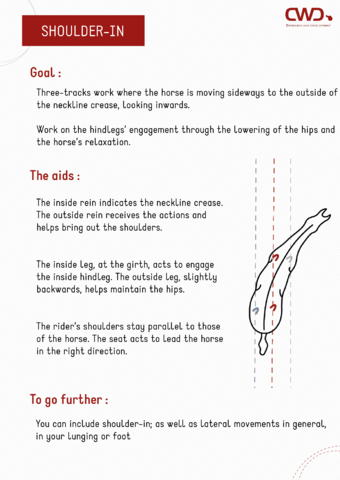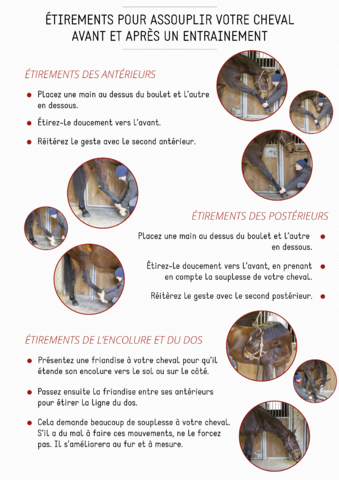Only 300,00 € left to enjoy free shipping!
No products
Only 300,00 € left to enjoy free shipping!
No products
Too often riders solely focus on the muscle aspect and ignore the beneficial effects that loosening-up exercises can have on their horses. Indeed, flexibility plays an equally important role, especially regarding the horse’s gaits quality and range of movement. Stretching and musculation work are inseparable and must be carried out daily.
For a better understanding of the following exercises in this article, it is first necessary to focus on the horse’s functioning and his muscular system in general.

Theses muscles are categorized according to their roles and actions. Distinction is thus made between the « skeletal » muscles, which ensure the horse’s locomotion, and the « smooth » muscles, which ensure the horse’s internal functioning.
The movement muscles, influencing the horse’s locomotion, are divided into 5 groups:
Thus, muscles groups can be differentiated according to their actions. The “agonist” muscles will act together in the same direction. On the other hand, the « antagonistic » muscles will act in opposition, meaning they will work in opposite ways.

When training a horse, we will therefore focus on the two main muscular chains: the ventral chain and the dorsal chain.

It is mainly composed of flexor muscles such as pectorals, abdominals and iliopsoas muscles. When they contract, these muscles can lower and/or bend the neck, raise the back and articulate the hip.

It is mainly composed of extensor muscles such as the cervico-dorsal muscles, the iliocostal muscle (which is part of the “common mass”, in the back) and the buttocks. When they contract, these muscles can extend the neck, the back and the joint of the hip.
To help your horse progress, independently of its innate qualities, musculation and stretching must be an integral part of your training. It is thanks to this daily work that your horse will be able to increase its range of movement, perfect its gestures and ameliorate its balance and propulsion.
We were talking about it in our previous blog article on gymnasticising: the lateral movements.
Whether it is leg-yielding, shoulder-in, or even the half-pass for the most experienced ones, all lateral movements are highly beneficial to horses. These exercises allow to strengthen your horse in a harmonious way, but also to stretch him and improve his engagement. They require the horse to bend and move sideways so they can be demanding and should be done sparingly, in accordance with your horse’s abilities and your personal knowledge.

The iPULSE connected girth will be your ally when practicing this exercise! Thanks to the heart rate given in live, you can check that your requests are not too difficult for your horse to execute.
Gait transitions are also good stretching exercises, this time in a longitudinal way. They are basic work when you are looking to stretch your horse.
Intra-gait transitions are the most interesting here. Indeed, they make it possible to play with the muscular and articular amplitude of the horse. The goal is the same as during transitions between gaits: to obtain gait elasticity without deteriorating the horse’s general attitude. When lengthening the gait, you must ask your horse to increase his strides’ length without impacting his cadence. Your horse has to move forward, but not faster. He will then extend his forelegs thanks to the extensor muscles from his shoulder to the tip of his hoof. His back must stay flexible and his hindlegs must engage under his mass.
It is the same when you ask recollection from your horse; he must move upwards, without slowing down. He will then lower his hips and raise his forehand, his nape at the highest point.
To achieve a good recollection, your horse’s relaxation must be complete and his hindlegs must engage clearly under his mass in order to maintain the impulse.

Finally, working on neck bending and counter-bending is also a good way to improve your horse’s flexibility. Indeed, each horse has a more natural suppleness on one side rather than the other. Just like us, our horses can be either righties or lefties! The neck bending work will help to reduce this flexibility gap.
Working on circles, figure-eights or serpentines, will allow you to alternate the work on both reins as well as neck bending and counter-bending. When you ask your horse to bend, his muscles will work by “sides”. For example, when you are on a circle on the left rein, the muscles on the right side will extend whereas the muscles on the left side will contract. Thus, the more marked the bending (or counter-bending) you ask your horse, the more pronounced the stretching and contraction effect will be.
Besides these flexibility exercises which you can add to your warm-up or during your training, there are also exercises that you can do during your lunging and foot work sessions.

As previously mentioned, working on transitions and neck bending during lunging sessions is also a good way to make a horse become more flexible and to muscle him up.
By varying your circles’ diameter, you can work on a more or less pronounced neck bending while still being careful not to lose impulse and engagement. For those who know how to use them, you can even go further by using long reins which offer more control in particular to maintain the hips on the circle. Once your horse will have acquired the bending work, you will be able to link the transitions work by using specific voice codes or body language. What is interesting here is to understand how your horse react to your requests, how he moves and performs the movements you ask for. If you have difficulties to obtain clear and smooth transitions during mounted training, reviewing the basics during lunging work will be beneficial to progress once in the saddle.
Not yet covered in this article, jumping sessions in lunge is another advantageous exercise.
Jumping obstacles require horses to make great efforts. Indeed, when jumping, the horse will stretch his dorsal chain during the upward phase of a jump, and the ventral chain during the flight and the downward phase of the jump. This effort is all the more important for close jumps such as combinations or bounce jumps.
In free or in lunge, the horse will have the liberty to work on his balance, his body movements and his articulation during the jump without being hindered by his rider. You can install combinations and bounce jumps which will require your horse to articulate and to contract his abdominal muscles, putting his back line in tension. Once this exercise is understood by your horse, you can occasionally add it to your mounted work sessions.
There are stretching exercises that you can perform on your horse, allowing you to stretch his legs, his back line and his neck. These stretching can be done both before and after your training sessions.
